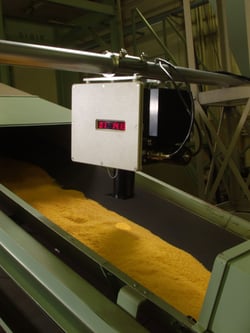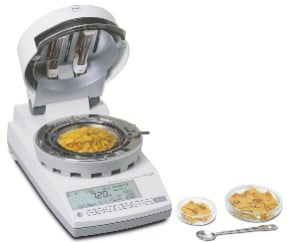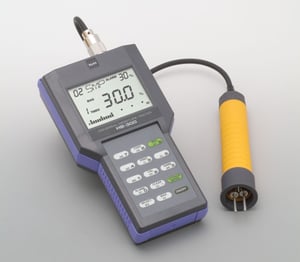 A composition analyzer can be a crucial instrument in any lab or production line setting, testing the makeup, efficacy, and quality of products, and evaluating all kinds of constituents besides moisture, including:
A composition analyzer can be a crucial instrument in any lab or production line setting, testing the makeup, efficacy, and quality of products, and evaluating all kinds of constituents besides moisture, including:
- Fats and oils
- Water activity
- Proteins
- Film thickness
- Coat weight
- Carbon content
- BTU
- Contaminants
Because of this, a composition analyzer can drastically enhance the precision and accuracy of your work; it can even detect harmful contaminants or flaws during the development phases or before a product reaches consumers. With the right calibrations, users can employ composition analyzers during research and development as well as production, to ensure a quality result.
In many cases—especially with traditional testing methods—determining a subject’s composition can be time-consuming and labor-intensive. This can cause testing, development, and quality control costs to skyrocket: Performing tests, delaying operations to wait for results, and even paying for the purchase and proper disposal of consumable products like reagents and chemicals for testing.
However, with the right instruments and careful planning, these lengthy test cycles can be cut, saving time and money. Here’s how having cutting-edge instruments—like those from Kett’s suite of Near Infrared (NIR) Composition Analyzers—can make all the difference during development and production.
The Benefit of ‘Faster:’ Dramatically Reduce Testing Cycles
By some accounts (especially with outdated testing equipment), sample preparation can be a labor-intensive process when testing the composition of a sample. But even once a sample is ready for testing, the work and the waiting have only begun. When testing moisture content with legacy composition analyzers, users can expect to wait between 5 to 15 minutes—or more—for reading.
When performing more complex chemical testing, the waiting time for these testing cycles extends exponentially. With some composition analyzers, one can expect to wait between 24 and 48 hours when testing for the presence of some constituents.
With Kett’s line of NIR composition analyzers, this time is cut to a tiny fraction of the previous test cycle length. NIR spectroscopy today can provide immediate, non-destructive laboratory quality readings in real-time, often with no contact with the sample, and most notably, with no sample preparation. Using these instruments, you can get precise readings of moisture, composition analysis, and even full-spectrum composition readings almost instantly.
This kind of full-spectrum testing allows users to measure a broad range of targeted factors in real time, with only preparation time needed for calibration. Users can then get accurate readings with a drastic reduction in the time each test cycle takes since readings are nearly instantaneous.
Faster and Less Expensive: Cut Down on Testing Costs with an NIR Composition Analyzer
NIR spectroscopy offers immediate, precise, high-quality readings in real-time, which not only cuts down on the test cycle time but also on the costs surrounding testing.
Switching from direct composition analysis to NIR composition analyzers can reduce testing costs by as much as 90 percent. This is true for several reasons:
- NIR composition analysis cuts the amount of labor (and payroll) needed for each test cycle
- NIR composition analysis eliminated the need to purchase and then pay for the disposal, of chemical reagents needed for testing
- NIR composition analysis dramatically decreases the instances of people-related errors that create the need for repeat testing
This is especially true of online testing models like the KJT700 Online Near-Infrared Composition Meter and the KJT270F Near-Infrared Composition Meter, which can test products in production in real-time, without having to pause for sample preparation or long test cycles, which can delay development and production.
Faster, Less Expensive, and More Accurate: Get More Reliable Results
As previously mentioned, NIR spectroscopy decreases the odds of human error in testing. Because NIR Composition Analyzers are designed with speed and accuracy in mind, there’s no learning curve for sample preparation—because for most models, there’s no sample to prepare at all, tests can be performed—even on the production line in some cases—without the risk of user error.
For desktop models (like the BS-F1000 Compact Fiber Beat Sensor and the BS-F1700 Compact Fiber Beat Sensor) and online models alike, the instrument takes a reading over the test subject (or product stream). Light is then transmitted through the sample (translucent or transparent) or reflected off the process sample with models like the Compact Reflective Beat Sensor, and Kett’s Composition Analyzer measures the amount of light absorbed by the subject. These absorbance readings are then converted—almost instantly—into component values analyzing the composition of the subject based on your exact calibrations.
Find the Right Composition Analyzer for Quick, Precise Results with Kett
Whether you’re focused on product development or production, Kett’s experienced engineers are eager to help you find the right instrument for your application.
To the casual eye, it may seem like there are almost as many composition analyzers out there as there are uses for them, but finding the perfect match for your needs, budget, and test cycle length can make all the difference in your outcomes—and can help you narrow the field to select a precise, speedy composition analyzer that’s built to last and tailored to your specific needs.
Let’s get things moving quickly. Contact us today to learn more!


